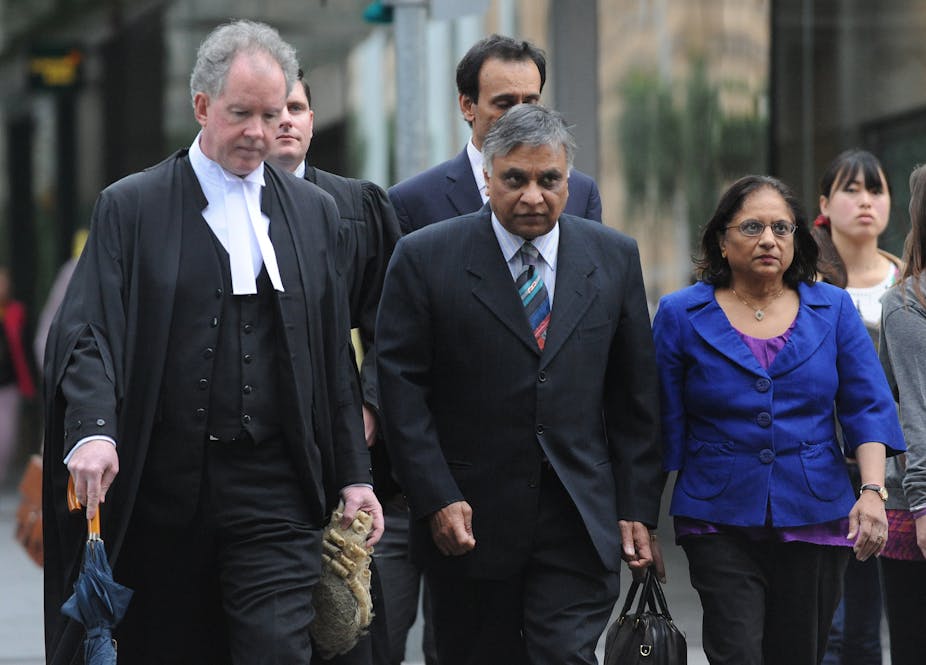The High Court has handed down its decision on Jayant Patel’s appeal against his conviction on three counts of manslaughter and one count of grievous bodily harm.
It unanimously upheld Patel’s appeal on the basis that there was a miscarriage of justice, and has ordered a retrial. He has been granted bail ahead of a retrial.
Issues of contention
There were two grounds on which Patel’s lawyers based their appeal. The first was that miscarriage of justice occurred because the prosecution brought its case under the wrong section of Queensland’s Criminal Code (section 288). That section seems only to apply to the actual performance of surgery: requiring that surgery be performed with a reasonable standard of care and skill. It doesn’t seem to apply to a decision to recommend surgery in the first place.
By day 43 of Patel’s trial, the issues had been narrowed down to whether the surgery should have been performed at all. On this basis, Patel’s defence argued that section 288 couldn’t apply because it didn’t concern the decision to recommend the surgery. The trial judge and the Court of Appeal held that it did. And the High Court agreed, dismissing this aspect of Patel’s appeal.
The second ground of appeal was that the prosecution radically changed its case on the 43rd day of the trial. This meant that a lot of irrelevant evidence had already been put before the jury and was likely to have influenced the jury’s verdict, resulting in a miscarriage of justice.
During the trial, Patel’s team sought to discharge the jury for this reason, but failed. And the Court of Appeal rejected their appeal on this ground. But the members of the High Court unanimously upheld Patel’s appeal, and have ordered a retrial.
The court’s reasoning
The reason for the High Court’s decision is that, before the Crown had narrowed its case down to the decision to operate at all, evidence had been presented that Patel had been incompetent and grossly negligent in the way in which he had carried out the surgery, and in the post-operative treatment he supervised.
By the time these claims had been abandoned, however, that irrelevant evidence had already been placed before the jury. This was likely to have influenced their decision on the much narrower issue of whether the surgery should have been undertaken at all. Regardless of whether the allegations had a strong basis, once it is conceded that they are not relevant to the case, they should not go before the jury.
Broader implications
The court’s decision on the first ground (that section 288 could apply to decisions to carry out surgery at all) is most important in terms of legal implications. The wording of the section seems to restrict the meaning of “surgical treatment” to the act of carrying it out, because it says that the person must have reasonable skill and use reasonable care “in doing such act”. The words “in doing such act” seem to refer to the act of doing the surgery, not to any decision to do it in the first place.
But the High Court, perhaps surprisingly, found that the provision is “not ambiguous” (Heydon J) and that those words do capture “the formation of a judgement about whether surgery should be recommended”.
Indeed, Heydon J goes further and holds that they also include “advice not to undergo particular forms of surgery”. This seems to be a natural consequence of the High Court’s finding, because, as the trial judge noted, if the word “act” included the recommendation of the surgery, the only way in which the duty to exercise reasonable care and skill could be satisfied by Patel is by advising against the surgery.
This has the odd implication that a decision not to do surgery is itself surgical treatment, and it also means that under this section, what the law would normally classify as an omission (a decision not to undertake surgery) is an act. It also means that “undertaking” includes a decision not to undertake surgery, which is perhaps another oddity.
The joint judgement made it clear, however, that there could be no responsibility for a death or grievous bodily harm without the physical act of surgery. This means that, according to the joint judgement, the only decisions caught would be those which recommend surgery and then proceed with it, when the recommendation is grossly negligent.
Although perhaps strained, the upshot of the decision is that it is now clear beyond doubt that a person can be prosecuted for gross negligence for recommending surgery that should not have been recommended, even if the surgery was itself carried out competently.

